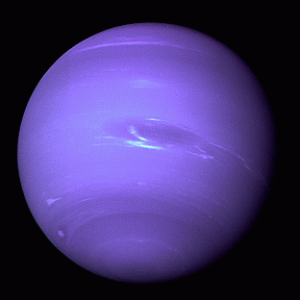The outer planets, worthy science targets in their own right, could also be considered something of a dry run for a true interstellar probe. And now details of a nuclear-powered mission to Neptune are beginning to emerge; they’re coming out of a 12-month planning study funded by NASA and led by Boeing Satellite Systems. Particularly intriguing about Neptune is its moon Triton, which many scientists now believe to be a Kuiper Belt object, a planetoid not formed by Neptunian debris but captured long ago by the planet’s gravity. A key part of the mission will be to deploy landers to Triton’s surface.
 A December 17 session at the American Geophysical Union fall meeting will be another shakedown of the concept, which the Neptune team has been fine-tuning at various conferences (and how I missed this one in Centauri Dreams‘ earlier story on the AGU is beyond me). The session is “A Neptune/Triton Vision Mission Using Nuclear Electric Propulsion.”
A December 17 session at the American Geophysical Union fall meeting will be another shakedown of the concept, which the Neptune team has been fine-tuning at various conferences (and how I missed this one in Centauri Dreams‘ earlier story on the AGU is beyond me). The session is “A Neptune/Triton Vision Mission Using Nuclear Electric Propulsion.”
Image: This picture of Neptune was produced from the last whole planet images taken through the green and orange filters on the Voyager 2 narrow angle camera. The images were taken 4.4 million miles from the planet. The image shows the “Great Dark Spot” and its companion bright smudge. Visible on the west limb are the fast-moving bright feature called “Scooter” and the “Little Dark Spot.” Credit: NASA.
The probe details are fascinating:
Propulsion: Nuclear-electric. After launch by chemical rocket, the probe would be driven by a nuclear fission reactor that would ionize an onboard propellant (presumably xenon gas); the electrically charged ions would be driven out the back to generate thrust. Work on nuclear-electric propulsion is the province of NASA’s Project Prometheus, which is studying power systems that can operate far from the Sun, where solar panels are insufficient.
Sensors: The Neptune mission will use sensors onboard the orbiter to study the composition of Neptune’s atmosphere, which should be more representative of primordial conditions in the Solar System than the inner gas giants Jupiter and Saturn. Atmospheric circulation, meteorology, magnetic fields and planetary chemistry are key areas for study.
Landers: Two Triton landers are being designed to study the strange geysers Voyager saw on the moon’s surface when it flew by Triton in 1989. And three atmospheric entry probes will be dropped onto Neptune itself, in the equatorial, mid-latitude and polar regions. How deep into the atmosphere to deploy these probes is still under investigation.
The so-called ‘ice giants’ are windows on the early Solar System. Says Neptune team member and radio scientist Professor Paul Steffes of the Georgia Institute of Technology:
“Because they are farther out, Neptune and Uranus represent something that contains more of the original – to use a ‘Carl Saganism’ – ‘solar stuff’ or the nebula that condensed to form planets…Neptune is a rawer planet. It is less influenced by near-sun materials, and it’s had fewer collisions with comets and asteroids. It’s more representative of the primordial solar system than Jupiter or Saturn.”
Centauri Dreams‘ take: The Neptune mission is expected to launch between 2016 and 2018, with arrival around 2035. Deep space missions demand a stretching of our time horizons that is utterly out of synch with a ‘do everything now’ society. In that sense, they challenge our perspective towards time and the contribution people make toward futures that seem remote at the time of their work. Now think interstellar: Even at ten percent of light speed, a Centauri probe would need 47 years before Earth-based controllers began receiving data from any planets there. To make things like interstellar probes happen will require changes that are cultural as well as technological, but we have the relatively long time-frames of the Voyager explorations to remind us that the payoff is tremendous.
Also noted from the AGU meeting: Wong, A. and S.K. Atreya, “Clouds of Neptune and Uranus: Implications for Entry Probes,” and Spilker, T.R. and A.P. Ingersoll, “Outstanding Science at Neptune: Aerocapture Implementation of NASA’s ‘Neptune Orbiter With Probes’ Vision Mission.” More on Neptune orbiter developments after the AGU meeting.
Sources: Georgia Institute of Technology; various NASA Web pages; American Geophysical Union 2004 fall meeting database.

